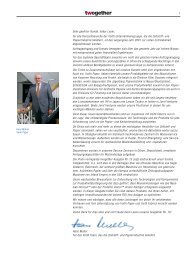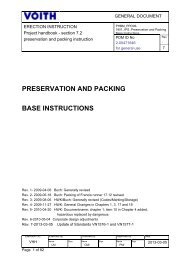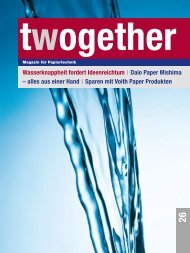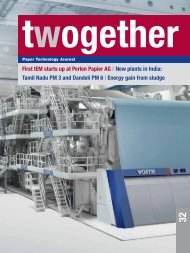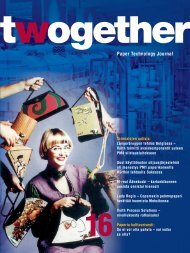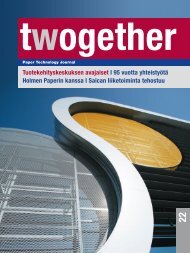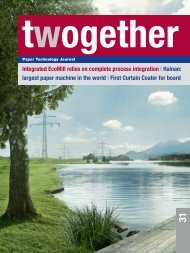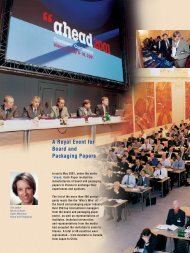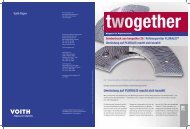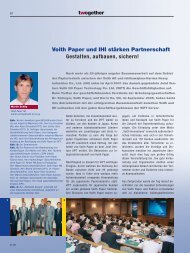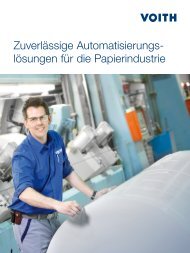Paper Technology Journal 19 - Voith
Paper Technology Journal 19 - Voith
Paper Technology Journal 19 - Voith
You also want an ePaper? Increase the reach of your titles
YUMPU automatically turns print PDFs into web optimized ePapers that Google loves.
Drum Pulper<br />
HD Cleaner<br />
Case study<br />
MC Screening Ø 1.4<br />
Reject<br />
Handling<br />
Flotation I<br />
Loop I<br />
HW Cleaner<br />
LC Screening // 0.15<br />
Disc Filter I<br />
Sludge<br />
Handling<br />
Screw Press<br />
DAF<br />
After seven years of production and growing<br />
competition on the Asian market, a<br />
newsprint mill using 100% recovered<br />
paper needed to take fundamental steps<br />
to strengthen its market position. The<br />
entire paper production process was analyzed<br />
to show the best ways of enhancing<br />
product quality and increasing productivity.<br />
Results from analyzing the stock<br />
preparation and approach flow<br />
The stock preparation line is a classical<br />
system with two water loops (Fig. 1) and<br />
intermittently operating final stages in<br />
Disperger<br />
Loop II<br />
Flotation II<br />
Disc Filter II<br />
Storage Tower<br />
PM Loop<br />
Approach Flow<br />
PM 1/PM 2<br />
Saveall<br />
hole and fine slot screening and in the<br />
cleaning system.<br />
The stock sample analysis results<br />
showed an extremely high stickies content<br />
in the final stages of these subsystems.<br />
Due to badly adjusted intermittent<br />
operation of each final stage, large quantities<br />
of stickies were washed into the accepts<br />
and re-entered the previous stage.<br />
This led to stickies concentration in each<br />
of these final stages. A large proportion<br />
of these stickies was broken down by this<br />
recirculation and they then found their<br />
way into the downstream subsystems.<br />
Some of them reached the paper machine<br />
as microstickies, clearly causing problems<br />
such as deposits on the felts as well<br />
Fig. 1: System configuration of a newsprint<br />
production plant.<br />
Fig. 2: COD values as an indication of how far<br />
the counterflow principle is followed.<br />
53<br />
1 2<br />
Sample<br />
point for<br />
clear<br />
filtrate<br />
1st water<br />
loop<br />
2nd water<br />
loop<br />
PM water<br />
loop<br />
Before optimization<br />
(measurement)<br />
> 4000<br />
Before optimization<br />
(balancing)<br />
After optimization<br />
(balancing)<br />
COD<br />
Chemical oxygen demand<br />
[mg/l]<br />
941<br />
235<br />
4682<br />
1104<br />
288<br />
1678<br />
231<br />
60<br />
as dust and flocks on the drying cylinders.<br />
Since intermittently operating final stages<br />
demand exceptionally sensitive adjustment<br />
of the operating and wash cycles,<br />
simple rebuild measures were recommended<br />
in both cases. The result was<br />
user-friendly continuously operating final<br />
stages with a high removal efficiency.<br />
During the WEP analysis a higher than<br />
normal gas content was detected in the<br />
headbox, causing unstable operation of<br />
the paper machine. To reduce this gas<br />
content, the mill added increasing<br />
amounts of defoamer despite the adequately<br />
dimensioned deaeration system.<br />
<strong>19</strong>/05



